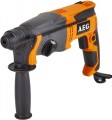Real power
The power given out by the perforator directly to the drill or other working equipment. This figure is inevitably lower than the power consumption (see below) due to energy losses in the tool mechanisms.
In general, higher net power means more efficiency and productivity; the reverse side of these advantages is an increase in price, energy consumption, dimensions and weight (however, the latter is not always a drawback for rotary hammers). In addition, note that tools with similar useful power values may differ in the ratio of chiseling speed and impact power: remember, a higher frequency means less energy for each individual impact, and vice versa. So the big numbers in this paragraph can mean both high efficiency when working with hard, stubborn materials, and good performance on relatively simple tasks; these features need to be specified separately.
Also, by the ratio of useful and consumed power, one can evaluate the efficiency of the tool in terms of energy consumption: the lower the power consumption (with the same useful power), the more efficient this model is. The downside of energy efficiency is often increased cost, but it can be recouped fairly quickly in energy savings, especially if you work long hours and often.
Power consumption
Rated power consumed by the rotary hammer during operation. Usually, the maximum power consumption in normal operation is taken as the nominal power.
In general, the higher this indicator, the heavier and more performant the rotary hammer is, the more advanced its performance usually turns out to be. On the other hand, the electricity consumption of such tools is high. In addition, note that with the same power consumption, the actual set of individual characteristics for different tools may be different. For example, frequency and impact energy are inversely related, and for the same power input, higher frequency usually means less individual impact energy. So, according to this parameter, it is worth evaluating only the overall level of the instrument; for accurate selection for specific tasks, you need to pay attention to more specific characteristics.
Also note that power consumption data can be useful for some tasks related to catering — for example, if a construction site is powered by an autonomous generator and you need to estimate the load on this energy source.
Impact energy
The energy transmitted by the perforator to the material being processed upon impact; the higher this indicator, the stronger and more powerful each individual blow.
First of all, we recall that the energy of impacts is directly related to their frequency: an increase in frequency leads to a decrease in energy. Therefore, for models where the number of strokes can be adjusted, this paragraph usually gives the maximum energy achieved at the minimum speed of operation.
In general, higher impact energy improves efficiency when working with hard, stubborn materials, but requires more motor power (especially if it has to be combined with a high frequency). Therefore, it is worth choosing according to this parameter, taking into account specific tasks. So, for occasional use in everyday life, an energy of 2 J or less is enough, for home repair work of medium intensity, at least 3 J is desirable; a power of
4 J or more is already considered high; and in some industrial-grade perforators, this figure can reach 30 J.
Rated load speed
The revolutions developed by the rotary hammer motor at the rated load on the tool.
Rated is usually considered the greatest load that the tool is able to transfer without breakage for a sufficiently long operation. Anyway, this parameter is indicated relatively rarely, since idle speed is traditionally considered the main characteristic (see "Number of revolutions" above). However, load speed data also allows you to evaluate some of the features of the rock drill. So, higher rated load speeds (at the same idle speed) in fact means at least higher productivity, and in many cases also the ability to cope with complex tasks more efficiently.
Concrete drilling max. ⌀
The maximum tool diameter that can be used with a rotary hammer when drilling in concrete. See "Maximum drilling diameter in wood" for details.
Weight
The weight of a fully assembled rotary hammer (in the case of battery power, with a standard battery installed). Unlike many other types of equipment, in the case of rotary hammers, light weight is far from always an advantage. So, heavy models are better suited for professional use — they are less prone to vibrations and, usually, are stronger, which is important when working with difficult-to-cut materials for a long time. But for small, simple works of short duration, a lot of weight is not required, and in this case,
light models are useful, which do not require significant effort to hold on weight.

